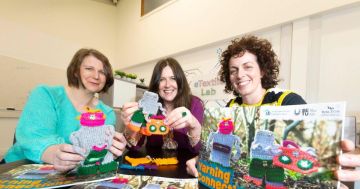Walton Institute publishes free e-textile knitting and crochet patterns</i>
Crafters, knitting and crochet enthusiasts have delved into the world of electronic textiles (e-textiles), wearable conductors and electronic components resulting in the development of unique electronic knitting and crochet patterns. Following the launch of the pattern booklet, the ‘Yarning Connections’ pattern is now accessible online, serving as a free resource and an introduction for those keen on exploring e-textiles.
Waterford community groups engaging in STEM
Led by Walton Institute at South East Technological University (SETU) the ‘Yarning Connections’ project, funded under Science Foundation Ireland (SFI)’s Discover programme, brought together traditional yarn crafters, knitting and crochet community groups from Waterford and the surrounding area.
The 37 participants teamed up with technical experts from Walton Institute’s e-textiles lab, crochet partner, Jacqui Kelleher, and knitting partner, Caroline O’Toole, to actively engage in a STEM (Science, Technology, Engineering and Maths) exploration of e-textiles.
Through peer-to-peer knowledge sharing workshops and collaborative idea generation, a core workshop group of yarn crafters delved into the integration of various conductive yarns, experimenting with soft switches and textile circuits. Additional volunteers tested the patterns and provided invaluable feedback before their release.
E-textiles a growing industry
E-textiles are fabrics that have electronic components either woven into or attached to them. Such electronic components include lights, sensors, and even small computers, enabling users to create textile items that can light up, sense things around them, or even respond to touch or movement. Combining the worlds of electronics and textiles makes it possible to create such items with enhanced functionality.
E-textiles is a growing industry and the global e-textiles market size reached USD 0.74 billion in 2023 and is projected to hit USD 1.63 billion by 2032, industry sources believe. Demand is increasing all the time for such wearable technology across healthcare, aerospace and the sports and fitness sectors in particular. However, to date, there is a lack of e-textile instructional information for needleworkers to understand the STEM side of e-textiles. Yarning Connections aimed to address that gap, moving e-textiles forward and bringing skilled makers to the arena.
Free patterns available now to download
Project lead, Aileen Drohan, said Yarning Connections was a huge success. “It was a fantastic, collaborative exploration of the integration of simple electronic circuits in knitting and crochet with conductive yarn across a series of workshops. The insights gained from these workshops were instrumental in co-creating the electronic knitting and crochet patterns. These patterns are now free for anyone to use and available here.
“The entire project was funded under the SFI Discover Programme, which aims to support and develop the STEM education and public engagement sector in Ireland by investing in, developing and extending activity and ability in this area, and exploring and encouraging novel means of engaging the public.
“Yarning Connections brought together a vibrant, enthusiastic group of yarn crafters, knitting and crochet enthusiasts who really enjoyed their time with us and engaged openly and freely with the technical experts from Walton Institute.
“We now have a new and sustainable network of skilled e-textile crafters who are keeping the old traditional craft methods alive, while also gaining practical skills in the practice of e-textiles as potentially complementary disciplines.”
Dr Frances Cleary, Head of the Mobile Ecosystem and Pervasive Sensing (MEPS) Division at Walton Institute, was delighted with the outcomes. “This project provided a pathway for traditional yarn crafting communities who typically don’t engage in STEM-related activities to embrace and understand e-textiles. Releasing new electronic patterns under a Creative Commons (CC) licence makes it free to share and modify, keeping the tradition of pattern sharing and re-mixing alive for centuries to come.”
Wearable technology for monitoring health
Marika Dunne’s family has a history of diabetes and taking part in the Yarning Connections project opened her eyes to the value of e-textiles in wearable technology to monitor such conditions. The mother of two also said it would make her more open to wearing e-textiles to monitor her glucose levels, blood pressure etc and manage her own pre-diabetes.
“I really enjoyed it. I only began to crochet 6 months before I started on the project. A friend of mine showed me and joined the project with me. I was fortunate to be able to see it through to the very end and was involved in testing the pattern and everything,” she said.
Avid knitter Mary Fearon formerly worked on the busy reception desk of the ArcLabs Research and Innovation Centre where the Yarning Connections project was based.
“It was really enjoyable. It was very interesting to sit down and marry knitting and technology. The instructions we were given were great and easy to follow, even though I’m definitely not a tech person.”
Knit and crochet robot figures
The free-to-use Yarning Connections patterns guide e-textiles enthusiasts through the process of crafting 2D robot figures, along with a selection of e-textile accessories that light up when snapped onto a robot figure. All accessories are interchangeable between the knit and crochet robot figures, allowing for experimentation with either or both crafts.
The 42-page Yarning Connections pattern includes easy-to-follow explanations and guides to conductive yarn, adding circuit parts to the knit/crochet body, how circuits work, troubleshooting on what causes LEDs to dim or stop lighting. The free-to-use booklet also includes a complete troubleshooting guide for any problems that might arise along the way.


